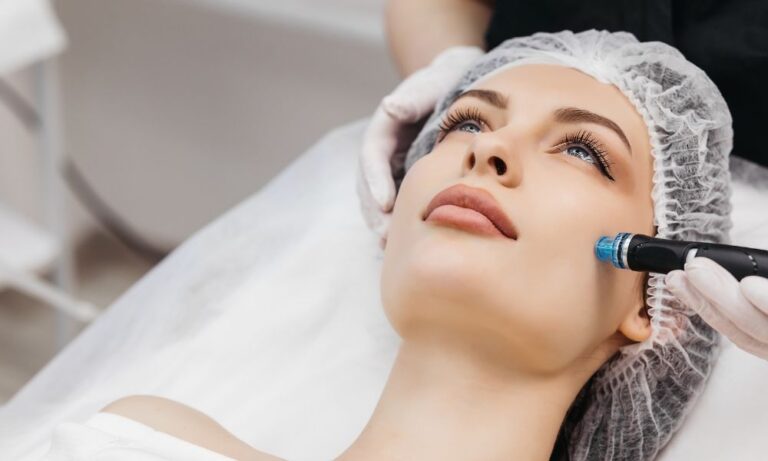When Lady Macbeth cries, “Out, damn’d spot!” the mark she berates is marring her conscience – not her complexion. Lucky her.
A lifetime of sun exposure means that the spots on your face are probably as plain as day. “This discolouration doesn’t discriminate – it’s a problem that all women over 40 eventually develop,” says Susan Taylor, MD, director of the Skin of Color Center at St Luke’s-Roosevelt Hospital in New York City.
Even if skin is wrinkle free, the resulting spots can add years to your look, making others view you as unhealthy and up to 10 years older, according to recent research.
Still, spots needn’t drive you mad. Whether you want to treat them yourself or visit a pro, a range of remedies – from bleaching agents to high-tech lasers – will help you see speckled skin isn’t a tragedy after all.
THE MOST IMPORTANT STEP TO PREVENTING SPOTS
Apply a broad-spectrum sunscreen with an SPF of at least 15 (30 is best) every day. This blocks the UV rays that speed up the production of melanin, the pigment that gives skin colour.
For extra protection, layer it over a cream or lotion that contains an antioxidant such as green tea, coffee berry, or vitamin C.
AT-HOME FIXES
OTC options may take months to show improvement, but they’re budget friendly and the least irritating.
Step 1. Apply a product with 2 per cent hydroquinone directly onto spots. The most potent skin lightener, HQ suppresses the enzyme needed for melanin production.
Diligent nightly application can result in complete clearing of mild to moderate spots within four weeks, says Heather Woolery-Lloyd, MD, an assistant professor of dermatology at the University of Miami School of Medicine.
One caveat: Even low doses of HQ can cause irritation; to lower the risk, start by applying every other evening and build up to nightly use.
Step 2. Once spots subside, switch to a cream with glucosamine or niacinamide (a B vitamin) to maintain results.
Consider Sepiwhite. This new nonirritating bleacher for mild mottling does double duty: It suppresses the production of melanin and its migration into skin cells, explains Jeffrey Dover, MD, a clinical associate professor of dermatology at Yale University.
Studies show that Sepiwhite significantly increases luminosity and lightened spots in two months.
For even faster clearing, use an exfoliator with retinol or glycolic acid to drive any bleacher deeper into skin.
IN-OFFICE SOLUTIONS
Although more costly, prescription remedies are faster, sometimes immediate solutions.
Step 1. Use an Rx retinoid nightly to speed cell turnover and even skin tone.
Step 2. Pair your retinoid with an Rx 4 per cent HQ cream. The combo can eliminate the most severe spots in as little as four to six weeks.
Both ingredients are irritating, so use as advised. To avoid worsening discolouration, apply for no longer than 60 days in a row three times a year, says Taylor.
Consider microdermabrasion or chemical peels. They even out mottling by polishing skin’s surface or dissolving dead cells. Plan on three to five treatments at about $200 a pop.
Consider light therapy. Intense pulsed light therapy (IPL) offers the fastest fix, zapping away both brown and red pigment, making it ideal for those who also have broken capillaries or ruddiness.
“The light superficially burns the spots and makes them a bit darker for a couple of days,” says Woolery-Lloyd. “They peel off in less than a week, revealing fresh skin.”
Depending on the severity of your discolouration, you’ll need three to six monthly treatments at about $250 a session. Expect slight stinging and redness that disappears within a few days.
Mystery spots, explained
If you’re seeing dark patches above the lip, on the forehead, or along the temples, you may have melasma. “A boost in estrogen from pregnancy, hormone therapy, or birth control pills is the most likely culprit,” says Dover. Melasma may clear once hormones stabilise, but treatment is usually needed.
The OTC potions that fade sun spots deliver modest improvement. A more potent prescription bleacher such as Tri-Luma (with 4 per cent HQ, a retinoid, and a skin-calming cortisone) often delivers complete clearing after three months.
For stubborn cases, a fractionated laser like Fraxel can erase discolouration after four to six sessions at $1130 per visit. UV exposure exacerbates melasma, so protect skin daily with sunscreen.
Copyright 2008. All rights reserved by New York Times Syndication Sales Corp. This material may not be published, broadcast or redistributed in any manner.






